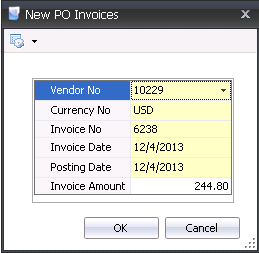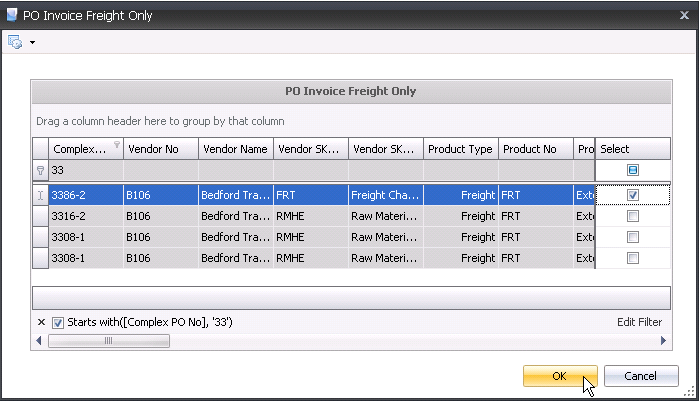Freight Purchase Invoices are used to process freight transactions, and are only used for transport vendors and freight costs that have been posted on a product receiving transaction. Multiple receiving transactions can be processed on one invoice. This document outlines the steps to create a freight purchase invoice.
The following options are outlined in the Freight Purchase Invoice:
In General>Purchases>Invoices,
select the drop-down menu on the  button and select
Freight Invoice.
button and select
Freight Invoice.

The purchase invoice header contains the base data for the invoice, such as vendor, invoice number and invoice date. The purchase invoice header is divided into three sections within the header grid.

The Details grid contains two tabs:
 .
.


PO Line Item is assigned by default and indicates the purchase order for the selected invoice line.
Entity No is an optional field to identify the entity that received the order.
Record Type indicates the location type.
Vendor SKU No represents the freight vendor sku that was received.
Invoice Discounts indicates the total amount of discounts defined on the purchase order and calculated based on the receiving transaction..
Invoice Taxes indicates the total amount of applicable taxes as defined on the purchase order and calculated based on the receiving transaction based on the rate that is in effect on the received date.
Invoice Bonus is not applicable to freight invoices.
Invoice Penalty is not applicable to freight invoices.
Invoice Total Amount indicates the total amount payable to the vendor for the freight invoice line.
Received Quantity is not applicable to freight invoices.
Received Unit Price is not applicable to freight invoices.
Received Amount is the freight amount calculated on the receiving transaction based on the received quantity and the purchase order price. This may be different than the Invoice Amount if the user modified based on the Price Mode.
Received Premiums Total is the total amount of premiums as calculated on the receiving transaction based on the received quantity and the purchase order details.

Received Discount Total is the total amount of discounts as calculated on the receiving transaction based on the received quantity and the purchase order details.
Received Bonus is not applicable to freight invoices.
Received Penalty is not applicable to freight invoices.
Received Total is the calculated total amount of the receiving transaction including product, add-ons, penalty/bonus and taxes.
Received Tax Total indicates the total amount of applicable taxes as defined on the purchase order and calculated based on the receiving transaction based on the rate that is in effect on the received date.
Price Variance indicates the difference between the Total Invoice Amount and the Total Received Amount. If the Price Variance is equal to 0, the invoice is automatically Approved. Otherwise, there is a threshold switch in setup to determine if the variance is within the acceptable tolerance. If the tolerance factor is set to 0%, all variances must be manually approved. This tolerance is established in Registry>Product Types>PO Invoice Percent Approval Threshold.
Currency Effective Date is used for multi-currency transactions. The field will define the date for the rate that is applicable to the purchase invoice.
Currency Exchange Rate automatically sets to the current exchange rate based on the rate that is in effect on the invoice date. If the rate is different than the exchange rate incurred at receiving, the difference in the converted amount payable will be coded to the foreign exchange gain/loss account.
Taxes tab displays the calculated tax amounts for the freight invoice. Taxes must be added to the purchase invoice if the taxable flag is marked on the vendor sku or any of the attached premium or discount add-ons.

Tax No identifies the tax code that is applied to the product and add-ons for the selected line item. The Taxable flag must be selected in the product and add-ons for taxes to calculate.
Tax Name describes the selected tax code.
Amount will display the calculated amount of the tax based on the tax calculated on the receiving transaction. If the amount is required to be modified, the Tax Override option must be selected on the invoice line and the tax amounts modified in the Taxes tab located in the child grid.
Within the PO Line Item tab, there is a child grid with additional tabs
that can be created. The details in the child grid will default from the
vendor sku with the option to modify. Click ![]() to
display the child grid for the PO Line
Item.
to
display the child grid for the PO Line
Item.
The add-ons default from the receiving transaction based on the received quantity and the add-on details defined on the purchase order. Depending on the Price Mode, the amounts may or may not be modified. It is important to note the different type of add-ons and those that will transfer to the invoice based on the Payment Type. The following guidelines are the same regardless of whether the add-on is a premium or discount.
| Payment Type | Receiving Transaction |
Purchase Invoice |
| Transaction | Always |
Yes, if Payee Type = not set |
| Rebate | Always |
Never |
| Internal | Always |
Never |

Transaction Basis is a read-only field that defaults from the receiving transaction as defined on the purchase order.
Payment Type determines when the add-on payment is made. The Payment Type on the invoice will only be Transaction as the other modes do not transfer to the purchase invoice.
The Payee Type will always be 'Not Set' as those are the only transaction types that default to the purchase invoice.
Transaction Entity ID will always be blank as those are the only transaction types that default to the purchase invoice.
Tax amounts will default from the receiving
transaction based on the rate that is in effect at receiving. If the tax
codes are missed on the purchase order or the tax amount is incorrect,
there is a tax override option to adjust the amounts. The Tax Override
flag must be selected for the taxes to be modified.

Tax No identifies the tax code to be applied to the product and add-ons for the selected line item. The Taxable flag must be selected in the product and add-ons for taxes to calculate.
Tax Name describes the selected tax code.
Amount
will display the total amount of taxes on the product. If the Amount
needs to be modified, select the Tax Override flag and enter the required
amount.
The Receiving screen displays the receiving transactions entered for the purchase invoice. The view is read-only for information purposes only.

 to save the freight purchase invoice and close the transaction.
to save the freight purchase invoice and close the transaction.Once the Freight Purchase Invoice has been created and saved, the invoice needs to be posted. The posting process locks the purchase invoice to prevent edits, and creates the journal transaction to record the liability. The UnPost option unlocks the invoice and reverses the journal transaction.
In order for the invoice to be posted, it needs to be in Approved status. The invoice will automatically default to Approved status if the invoice amount matches the received amount exactly or within the defined tolerances.
 button in the main menu.
button in the main menu.The posting process creates the journal transaction. The journal will reverse the accounts payable accrual that was incurred when the product was received and record the payable amount to the vendor.
| DEBIT | Accounts Payable Accrual |
| CREDIT | Accounts Payable |
